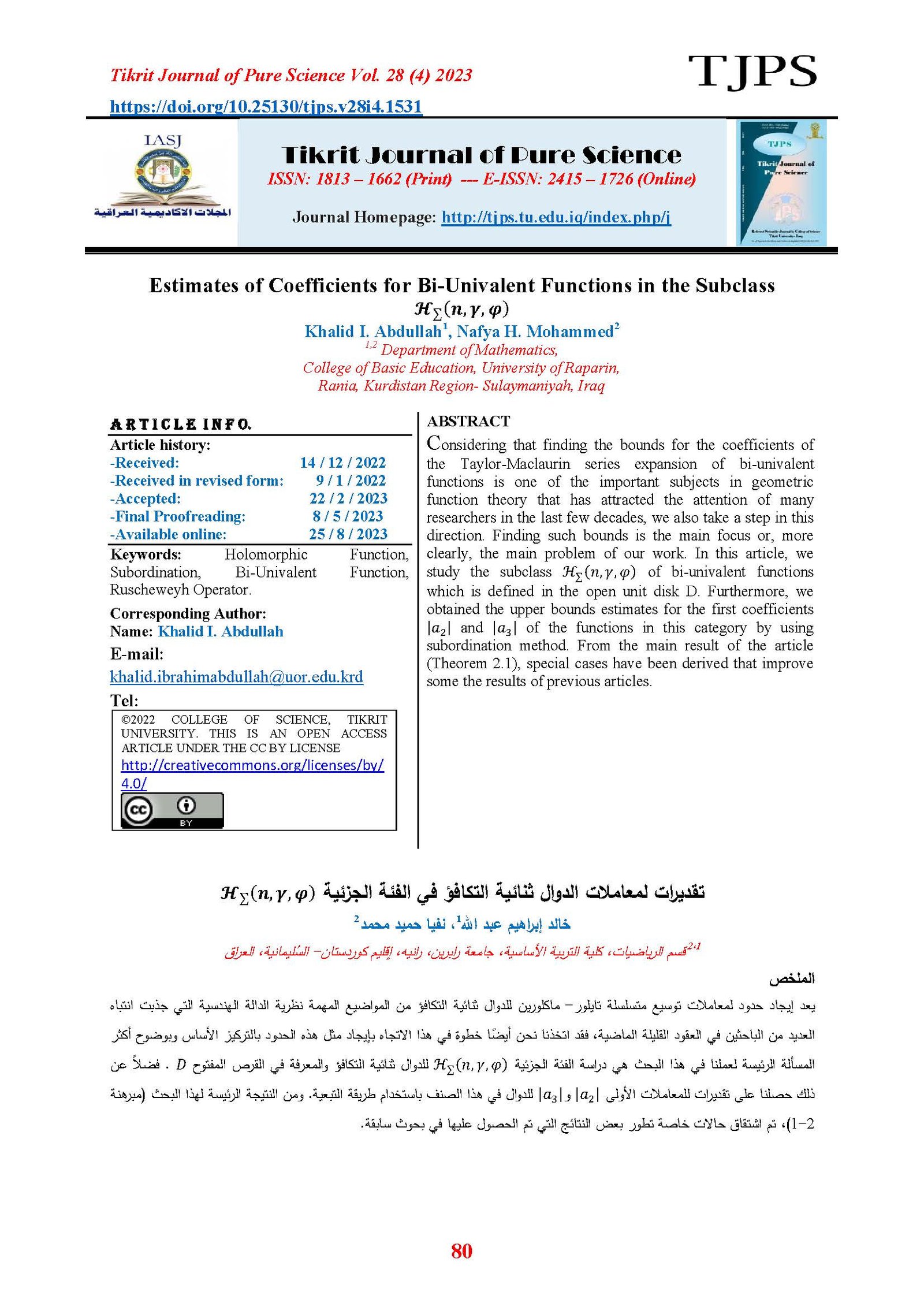Estimates of Coefficients for Bi-Univalent Functions in the Subclass H_∑ (n,γ,φ)
Main Article Content
Abstract
Considering that finding the bounds for the coefficients of the Taylor-Maclaurin series expansion of bi-univalent functions is one of the important subjects in geometric function theory that has attracted the attention of many researchers in the last few decades, we also take a step in this direction. Finding such bounds is the main focus or, more clearly, the main problem of our work. In this article, we study the subclass H_∑ (n,γ,φ) of bi-univalent functions which is defined in the open unit disk D. Furthermore, we obtained the upper bounds estimates for the first coefficients |a_2 | and |a_3 | of the functions in this category by using subordination method. From the main result of the article (Theorem 2.1), special cases have been derived that improve some the results of previous articles.
Article Details

This work is licensed under a Creative Commons Attribution 4.0 International License.
Tikrit Journal of Pure Science is licensed under the Creative Commons Attribution 4.0 International License, which allows users to copy, create extracts, abstracts, and new works from the article, alter and revise the article, and make commercial use of the article (including reuse and/or resale of the article by commercial entities), provided the user gives appropriate credit (with a link to the formal publication through the relevant DOI), provides a link to the license, indicates if changes were made, and the licensor is not represented as endorsing the use made of the work. The authors hold the copyright for their published work on the Tikrit J. Pure Sci. website, while Tikrit J. Pure Sci. is responsible for appreciate citation of their work, which is released under CC-BY-4.0, enabling the unrestricted use, distribution, and reproduction of an article in any medium, provided that the original work is properly cited.
References
[1] Lewin,M. (1967). On a coefficient problem for bi-univalent functions. Proceedings of the American mathematical society, 18(1), pp.63-68.
[2] Netanyahu, E. (1969). The minimal distance of the image boundary from the origin and the second coefficient of a univalent function in¦ z¦< 1. Archive for Rational Mechanics and Analysis, 32(2), pp.100-112.
[3] Brannan, D. A. (1980) The Lowner Differential Equation. In: Aspects of contemporary complex analysis, (pp. 79-95). Academic Press INC. London (University of Durham).
[4] Srivastava, H.M., Mishra, A.K. and Gochhayat, P. (2010). Certain subclasses of analytic and bi-univalent functions. Applied mathematics letters, 23(10), pp.1188-1192.
[5] Al-Ameedee, S.A., Atshan, W.G. and Al-Maamori, F.A. (2020). May. Coefficients estimates of bi-univalent functions defined by new subclass function. In Journal of Physics: Conference Series (Vol. 1530, No. 1, p. 012105). IOP Publishing.
[6] Atshan, W.G., Rahman, I.A.R. and Lupaş, A.A. (2021). Some results of new subclasses for bi-univalent functions using quasi subordination. Symmetry, 13(9), p.1653.
[7] Shehab, N.H. and Juma, A.R.S. (2021). Application of Quasi Subordination Associated with Generalized Sakaguchi Type Functions. Iraqi Journal of Science, 62(12), pp.4885-4891.
[8] Hameed Mohammed, N. (2021). Coefficient Bounds for a New Class of Bi-Univalent Functions Associated with Subordination. Mathematical Analysis and Convex Optimization, 2(2), pp.73-82.
[9] Ruscheweyh, S. (1975). New criteria for univalent functions. Proceedings of the American Mathematical Society, 49(1), pp.109-115.
[10] Hussain, S.,et al. (2017). Coefficients bounds for certain subclass of biunivalent functions associated with Ruscheweyh-Differential operator. Journal of Complex Analysis, 2017.
[11] Duren, P. L. (1983). "Grundlehren der mathematischen Wissenchaften."Springer-Verlag NewYork, Berlin, Heidelberg, and Tokyo. Vol. 259.
[12] Srivastava, H.M. and Owa, S. (1992). Current topics in analytic function theory. World Scientific.
[13] Cho, N.E., et al. (2019). The second Hankel determinant problem for a class of bi-close-to-convex functions. Mathematics, 7(10), p.986.
[14] Srivastava, H.M., Gaboury, S. and Ghanim, F. (2018). Coefficient estimates for a general subclass of analytic and bi-univalent functions of the Ma–Minda type. Revista de la Real Academia de Ciencias Exactas, Físicas y Naturales. Serie A. Matemáticas, 112(4), pp.1157-1168.
[15] Ma, W. (1992). A unified treatment of some special classes of univalent functions. In Proceedings of the Conference on Complex Analysis, 1992. International Press Inc.
[16] Mendiratta, R., Nagpal, S. and Ravichandran, V. (2015). On a subclass of strongly starlike functions associated with exponential function. Bulletin of the Malaysian Mathematical Sciences Society, 38(1), pp.365-386.
[17] ALREFAI, O. and Ali, M. (2020). General coefficient estimates for bi-univalent functions: a new approach. Turkish Journal of Mathematics, 44(1), pp.240-251.
